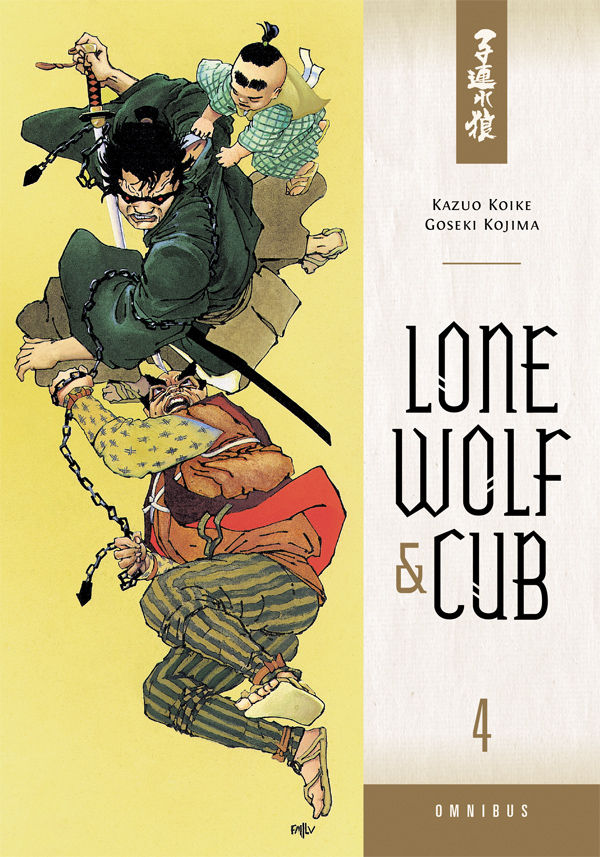Manga Mondays: Lone Wolf And Cub Omnibus Vol. 4 & Neon Genesis Evangelion
03/31/2014 3:31pm
Few works of graphic fiction have portrayed action so powerfully, so elegantly, and so kinetically as has Lone Wolf and Cub. But what sets LW&C apart from other graphic fiction is the extreme contrasts within its pages. As a fan of great storytelling, I’ve come to realize that contrast is the high-octane fuel of drama. The studious intellect of the Judge in Cormac McCarthy’s Blood Meridian magnifies the character’s savagery. The moment of sunlight and blue sky in the midst of The Perfect Storm renders the stricken sword boat’s plight absolutely crushing. The quiet passages in Nirvana’s "Smells Like Teen Spirit" turns the volume to eleven when the big chords come crashing down.
No one in comics history has understood this better than Kazuo Koike and Goseki Kojima. Trudging silently through the snow, ?gami Itt? and his son, Daigoro, are unaware that their mortal enemy, Yagy? Retsud?, has dispatched a legion of killers to ambush them. Father and son stop in a village and share a simple meal, a serene moment between them—until all hell breaks loose. Take away that quiet scene, running out to ten pages (an eternity in an American comic book) and the ensuing action, masterfully as it is presented, would fall short of the scene’s potential impact. The calm before the storm intensifies the
effect upon us.
I’m saddened that so many writers and filmmakers have forgotten this lesson—or never learned it—and try to fill every moment with sound and fury, a plate stacked high at an all-you-can-eat buffet. Even “quiet” scenes are often filled with incessant yammering by characters, as though the writers were paid by the word. Lone Wolf and Cub gives the reader time to reflect, time to breathe, and time to take in the implications of the story, not just its activities.
Lone Wolf and Cub Omnibus volume 4 lands softly, then explodes in comics shops April 2.
—Chris Warner, Senior Editor
[insert image Shinji Ikari Detective Diary Vol. 2.jpg here]
I wish The Shinji Ikari Detective Diary was a bit longer than it is, but unfortunately volume two, out this week, is where the story ends. You might think there's a lot of Evangelion spinoff manga out there—this is Dark Horse's fourth Eva title, after the still-running The Shinji Ikari Raising Project, the completed Campus Apocalypse, and the one-shot Comic Tribute (or, depending on how you count Comic Tribute, it's our twenty-fourth Eva title ^_^), but, as I like to point out, in Japan there's an entire monthly magazine devoted to nothing but Mobile Suit Gundam manga, Kadokawa's Gundam Ace. Say what you will about Hideaki Anno, he hasn't yet made a Evangelion Double Zeta or Evangelion Build Fighters. I mean, maybe someday, but not yet.
On the other hand, maybe we can go ahead and blame GAINAX for all those Gundam manga too; according to their longtime executive Yasuhiro Takeda, it was GAINAX that first came up with the idea of an all-Gundam manga magazine—way back in 1988, when the formerly-published Cyber Comix began running, originally edited by GAINAX's merchandising arm, General Products, and released through Bandai. As you might suspect, GAINAX also used the magazine to start running manga based on their own anime; first spinoffs of Aim for the Top! Gunbuster, and later ones from Nadia: The Secret of Blue Water. Some of those stories were as offbeat as any of the Evangelion spinoffs (one of my favorites was Noriko Takaya telling the story of her adventures as a mecha pilot by using kamishibai, traditional Japanese street theater done with drawings and narration). The point—and you knew there must be a point—is that manga spinoffs are nothing new for GAINAX, and, because they are a studio very conscious of their own fan roots, I don't doubt they were inspired to do so by doujinshi, the massive Japanese fan comics scene many of them participated (and still participate) in.
Almost all professional manga in Japan get serialized in magazines before they get collected as graphic novels, and broadly speaking (sometimes the actual concept can be a little vague), these magazines are designed to have distinct reader demographics that the manga are supposed to fit. That's true even if the manga are all based on a common series, such as Evangelion; in fact, the four Eva manga series published by Dark Horse ran in three separate magazines in Japan. Like a math puzzle, you can figure out that two of them must have run in the same magazine—and those two were Detective Diary and Campus Apocalypse, which both ran in Asuka (that's the magazine's name, although it's not an Evangelion-themed publication), catering to more of a shojo demographic.
I think this helps to explain why both manga seem to have more emphasis on Shinji and Kaworu; you'll notice that Shinji is on the cover of every volume of those two manga, whereas he hasn't been on the cover of The Shinji Ikari Raising Project in years, despite it being named, you know, "The Shinji Ikari Raising Project." Kaworu gets to be on most of those covers, too (Why doesn't Kaworu show up in Raising Project anymore? He was great. Perhaps it was a school safety issue, what with the fire alarms ringing constantly in his presence). It might also explain why Shinji displays a level of physical coordination and even coolness in those two books undreamt of in Raising Project (or in the anime, for that matter—I'm hoping the DVD of Evangelion 3.33 will contain bonus footage of Asuka dragging Shinji over rocks, brambles, jagged scrap metal, etc.).
You can't simply stamp "Evangelion" on a manga and have it sell; some of the spinoff manga are more successful than others. Each Eva manga is trying to do its own thing, in its own way. But that's as it should be, and you'll see in Vol. 2 of The Shinji Ikari Detective Diary that creator Takumi Yoshimura felt strongly motivated by the original Eva anime to give the manga the ending that it has. I think those sincere feelings alone justify Detective Diary; but it has its distinct charms as a story as well. We would certainly publish more if there was more, and we have to thank you, the readers, for the good reception you've given the manga. Don't forget—we always like to see your letters and fan art for all our Evangelion titles at evangelion@darkhorse.com!
—Carl Horn
Manga Editor

Few works of graphic fiction have portrayed action so powerfully, so elegantly, and so kinetically as has Lone Wolf and Cub. But what sets LW&C apart from other graphic fiction is the extreme contrasts within its pages. As a fan of great storytelling, I’ve come to realize that contrast is the high-octane fuel of drama. The studious intellect of the Judge in Cormac McCarthy’s Blood Meridian magnifies the character’s savagery. The moment of sunlight and blue sky in the midst of The Perfect Storm renders the stricken sword boat’s plight absolutely crushing. The quiet passages in Nirvana’s "Smells Like Teen Spirit" turns the volume to eleven when the big chords come crashing down.
No one in comics history has understood this better than Kazuo Koike and Goseki Kojima. Trudging silently through the snow, ?gami Itt? and his son, Daigoro, are unaware that their mortal enemy, Yagy? Retsud?, has dispatched a legion of killers to ambush them. Father and son stop in a village and share a simple meal, a serene moment between them—until all hell breaks loose. Take away that quiet scene, running out to ten pages (an eternity in an American comic book) and the ensuing action, masterfully as it is presented, would fall short of the scene’s potential impact. The calm before the storm intensifies the effect upon us.
I’m saddened that so many writers and filmmakers have forgotten this lesson—or never learned it—and try to fill every moment with sound and fury, a plate stacked high at an all-you-can-eat buffet. Even “quiet” scenes are often filled with incessant yammering by characters, as though the writers were paid by the word. Lone Wolf and Cub gives the reader time to reflect, time to breathe, and time to take in the implications of the story, not just its activities.
—Chris Warner, Senior Editor

I wish The Shinji Ikari Detective Diary was a bit longer than it is, but unfortunately volume two, out this week, is where the story ends. You might think there's a lot of Evangelion spinoff manga out there—this is Dark Horse's fourth Eva title, after the still-running The Shinji Ikari Raising Project, the completed Campus Apocalypse, and the one-shot Comic Tribute (or, depending on how you count Comic Tribute, it's our twenty-fourth Eva title ^_^), but, as I like to point out, in Japan there's an entire monthly magazine devoted to nothing but Mobile Suit Gundam manga, Kadokawa's Gundam Ace. Say what you will about Hideaki Anno, he hasn't yet made a Evangelion Double Zeta or Evangelion Build Fighters. I mean, maybe someday, but not yet.

I wish The Shinji Ikari Detective Diary was a bit longer than it is, but unfortunately volume two, out this week, is where the story ends. You might think there's a lot of Evangelion spinoff manga out there—this is Dark Horse's fourth Eva title, after the still-running The Shinji Ikari Raising Project, the completed Campus Apocalypse, and the one-shot Comic Tribute (or, depending on how you count Comic Tribute, it's our twenty-fourth Eva title ^_^), but, as I like to point out, in Japan there's an entire monthly magazine devoted to nothing but Mobile Suit Gundam manga, Kadokawa's Gundam Ace. Say what you will about Hideaki Anno, he hasn't yet made a Evangelion Double Zeta or Evangelion Build Fighters. I mean, maybe someday, but not yet.
On the other hand, maybe we can go ahead and blame GAINAX for all those Gundam manga too; according to their longtime executive Yasuhiro Takeda, it was GAINAX that first came up with the idea of an all-Gundam manga magazine—way back in 1988, when the formerly-published Cyber Comix began running, originally edited by GAINAX's merchandising arm, General Products, and released through Bandai. As you might suspect, GAINAX also used the magazine to start running manga based on their own anime; first spinoffs of Aim for the Top! Gunbuster, and later ones from Nadia: The Secret of Blue Water. Some of those stories were as offbeat as any of the Evangelion spinoffs (one of my favorites was Noriko Takaya telling the story of her adventures as a mecha pilot by using kamishibai, traditional Japanese street theater done with drawings and narration). The point—and you knew there must be a point—is that manga spinoffs are nothing new for GAINAX, and, because they are a studio very conscious of their own fan roots, I don't doubt they were inspired to do so by doujinshi, the massive Japanese fan comics scene many of them participated (and still participate) in.
Almost all professional manga in Japan get serialized in magazines before they get collected as graphic novels, and broadly speaking (sometimes the actual concept can be a little vague), these magazines are designed to have distinct reader demographics that the manga are supposed to fit. That's true even if the manga are all based on a common series, such as Evangelion; in fact, the four Eva manga series published by Dark Horse ran in three separate magazines in Japan. Like a math puzzle, you can figure out that two of them must have run in the same magazine—and those two were Detective Diary and Campus Apocalypse, which both ran in Asuka (that's the magazine's name, although it's not an Evangelion-themed publication), catering to more of a shojo demographic.
I think this helps to explain why both manga seem to have more emphasis on Shinji and Kaworu; you'll notice that Shinji is on the cover of every volume of those two manga, whereas he hasn't been on the cover of The Shinji Ikari Raising Project in years, despite it being named, you know, "The Shinji Ikari Raising Project." Kaworu gets to be on most of those covers, too (Why doesn't Kaworu show up in Raising Project anymore? He was great. Perhaps it was a school safety issue, what with the fire alarms ringing constantly in his presence). It might also explain why Shinji displays a level of physical coordination and even coolness in those two books undreamt of in Raising Project (or in the anime, for that matter—I'm hoping the DVD of Evangelion 3.33 will contain bonus footage of Asuka dragging Shinji over rocks, brambles, jagged scrap metal, etc.).
You can't simply stamp "Evangelion" on a manga and have it sell; some of the spinoff manga are more successful than others. Each Eva manga is trying to do its own thing, in its own way. But that's as it should be, and you'll see in Vol. 2 of The Shinji Ikari Detective Diary that creator Takumi Yoshimura felt strongly motivated by the original Eva anime to give the manga the ending that it has. I think those sincere feelings alone justify Detective Diary; but it has its distinct charms as a story as well. We would certainly publish more if there was more, and we have to thank you, the readers, for the good reception you've given the manga. Don't forget—we always like to see your letters and fan art for all our Evangelion titles at evangelion@darkhorse.com!
—Carl Horn
Manga Editor



